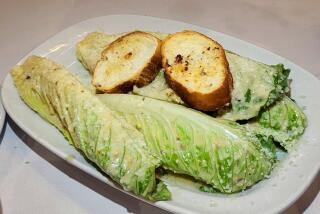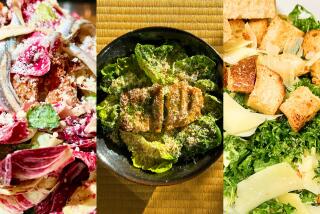FOOD : Repasts Remembered : Restaurateur Memoirs Bring Back Salad Days
THE MEMOIRS OF restaurateurs and hoteliers make wonderful reading. That’s partly, I think, because anyone who plies the innkeeper’s trade long enough to be able to write a memoir is almost certain to have acquired good powers of observation, some measure of empathy and a sense of humor along the way--not a bad set of traits for a writer to possess.
But it must also have something to do with the nature of their establishments. Restaurants and hotels aren’t just places to go for dinner or to spend the night. They’re microcosms of the society in which they function, reflecting social values, echoing fashion, helping to define celebrity. They’re fascinating institutions; thus their owners have fascinating tales to tell.
Unfortunately, though, these tales don’t get told as often as they used to. Restaurateurs write cookbooks these days, not affectionate remembrances. Modern hoteliers tell readers how they clawed their way to power, not how they charmed some particularly difficult guest. (Who’d want to read a memoir of a 900-room chain hotel anyway? What would the anecdotes be about? The time the credit-card link went down just as 375 chiropodists were trying to check out?)
Happily, a good many splendid hotel and restaurant memoirs from earlier times survive. Some of these are straightforward anecdotal histories--for instance, Simone Prunier’s 1957 book, “Prunier’s, The Story of a Great Restaurant” (whose first chapter is called “Paris in the Sixties”--meaning the 1860s), or “Memoirs of a Wayward Inn” by Frank Case (1938), longtime owner of New York’s famed Algonquin Hotel. (Here is Case on the theatrical profession, toward which he was notoriously solicitous: “People of unique abilities are unique creatures. . . . When you hear a woman of the theater described as sweet and gentle and just like anybody else, so much so that ‘you would never know that she is an actress,’ go to see her in the theater, and it’s a pretty good bet that she isn’t.”)
Other memoirs rewrite recollection with a novelist’s sense of pace and color--i.e., the hotel and restaurant stories of Ludwig Bemelmans’ “Hotel Bemelmans,” “Tell Them It Was Wonderful” and “La Bonne Table,” with their charming insouciance and their famous punch lines: The chef of a Viennese restaurant that advertised “cutlets from every animal in the world” to a countess who has just ordered a cutlet made of elephant: “Madame, I am very sorry, but for one cutlet we cannot cut up our elephant.”
Then there are the books of George Rector, who ran Rector’s restaurant in New York City. Rector’s might, I suppose, be described as the Spago of turn-of-the-century Broadway. Its regulars included O. Henry, Stephen Crane, George M. Cohan, John Philip Sousa, Lillian Russell, Oscar Hammerstein and Sarah Bernhardt. Death Valley Scotty found his way to the place, Rector reports, and ordered “twenty dollars’ worth of ham and eggs and a piece of pie.” Diamond Jim Brady used to book a table for 10, wait for friends to show up and then eat all 10 dinners by himself if no one came. Stanford White ate his last meal at Rector’s a few hours before he was shot to death by Harry K. Thaw, whom he had cuckolded.
“Rector’s may not have been the centre of population in the late 1890s and the early 1900s, but it was the centre of all the population worth knowing. . . . (It) was the supreme court of triviality, where who’s who went to learn what’s what. It was the cathedral of froth, where New York chased the rainbow and the butterfly netted the entomologist.” That’s George Rector himself speaking in “The Girl from Rector’s” (1927). Modesty was not his strong suit.
He is a joy to read, though--chatty, urbane, amusingly opinionated. Of a famous soup, for instance, he explains that “borsch (sic) is to Russia what clam chowder is to New England. Everybody eats it, and those who don’t eat it rub it into their hair.” Elsewhere, he reminds us that “baked potatoes and steak are old college chums,” and he notes disapprovingly that some people, in roasting wild duck, “grasp the duck firmly by the neck, hold it up to the fire and say: ‘Duck, meet the fire. Fire, meet the duck,’ and then serve.” Iced tea, he says, is “the finest iced drink that ever . . . kept a perspiring husband and an overheated wife from deciding it was all a hideous mistake.”
Speaking of summer fare, in “Dine at Home with Rector” (1934), Rector offers his recipe for potato salad--learned, he says, from an unnamed chef who was “the best artist in creamed potatoes who ever approached a stove on this side of the Atlantic.” Potato salad first became popular in this country in the late 19th Century, in both cold and hot (or “German”) versions. Most recipes for the former call for the potatoes to be cubed and then tossed immediately with a mayonnaise-based dressing. Rector’s is rather different--and the results are quite delicious. Here is the recipe, in a slightly edited version of Rector’s own words:
“You boil potatoes with their jackets on till tender, then peel them quickly and put them in a bowl. Dive into them with a couple of big forks, stabbing and pulling crosswise until they’re all broken up coarse and grainy. Give them our special family French dressing (see below) to drink, in proportions of a third of a cup to six medium potatoes, and let them marinate. When the dressing has permeated every atom, throw in half a cup of blanched almonds sliced very thin, a couple of tablespoons of fine chopped onion and another couple of tablespoons of fine chopped green peppers. Mix it thoroughly and chill it off in the refrigerator. Just before serving, mix in a whole cup of chilled mayonnaise and a tablespoon of fine chopped parsley and serve it on lettuce with paprika sprinkled here and there for garnish.”
Rector adds two helpful notes: “Mutilating your potatoes while they’re still hot and ‘floury’ gets rid of that appalling toughness to which the cold boiled potato is generally subject when sliced with a knife. And your cold boiled spuds needn’t go to waste because you don’t use them in potato salad; cold boiled is the best possible start on hashed brown, and I have yet to meet anybody who looked cross-eyed at hashed brown.”
The “family French dressing” that Rector calls for is made like this: “Rub two teaspoons of salt, a teaspoon of fresh ground pepper, a teaspoon of paprika, half a teaspoon of powdered sugar, half a teaspoon of powdered mustard and a few grains of cayenne all together in the bottom of a bowl. Then slowly drip in a cup of olive oil, stirring all the time until the dry stuff is emulsified. Into that, drip a quarter of a cup of vinegar, also stirred vigorously. Taste it, making sure your sample is thoroughly mixed, and make your own improvements on that base.”
More to Read
Sign up for our Book Club newsletter
Get the latest news, events and more from the Los Angeles Times Book Club, and help us get L.A. reading and talking.
You may occasionally receive promotional content from the Los Angeles Times.






